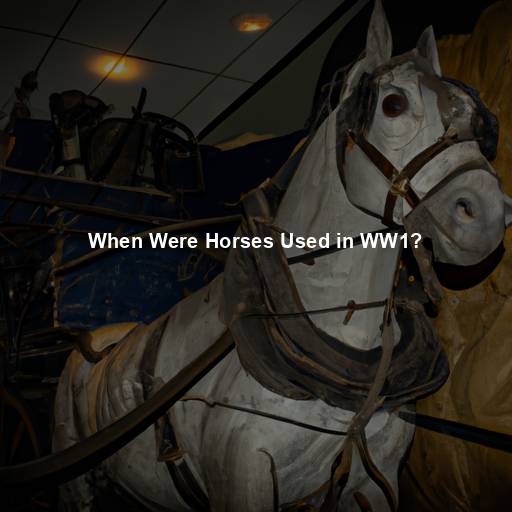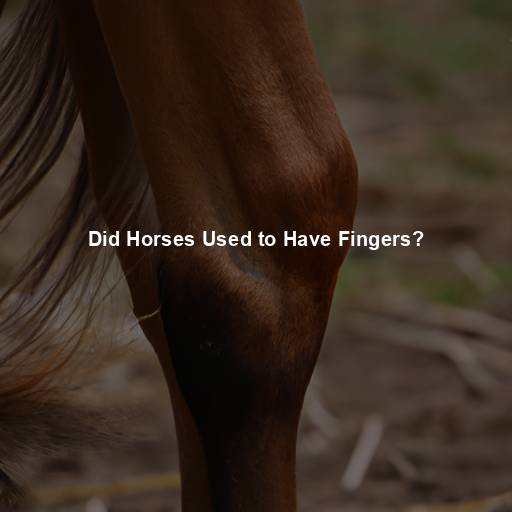Why Are Horses Dying at Churchill Downs?
Last Updated on October 25, 2023 by Evan
Contents [hide]
- 1 Understanding the Tragic Incidents at Churchill Downs Racetrack
- 2 The Importance of Public Awareness and Support
- 3 A Balanced Approach for the Future
- 4 FAQs: Why are horses dying at Churchill Downs?
- 4.1 How many horses have died at Churchill Downs?
- 4.2 What are some common causes of horse deaths at Churchill Downs?
- 4.3 How does Churchill Downs ensure the safety and welfare of horses?
- 4.4 Are there any specific improvements being made to address the issue?
- 4.5 Is horse racing inherently dangerous?
- 4.6 How does horse racing compare to other equine sports in terms of safety?
- 4.7 What steps are being taken to investigate horse fatalities at Churchill Downs?
- 4.8 What measures are in place to protect jockeys during races?
- 4.9 Does Churchill Downs have a good safety record overall?
Understanding the Tragic Incidents at Churchill Downs Racetrack
Over the past few years, the horse racing realm has found itself at the epicenter of controversy, besieged by formidable waves of scrutiny and disapproval. A specific racetrack, known far and wide for hosting the illustrious Kentucky Derby, has emerged as a focal point in this disquieting narrative – Churchill Downs. The profound loss of these majestic beings has left us with a bewildering sense of dismay, raising compelling questions and fueling impassioned debates regarding the well-being and security of these elegant creatures within the racing domain. Within the confines of this article, we embark on a thought-provoking journey, unraveling the perplexing reasons behind the heart-rending incidents at Churchill Downs, whilst shedding light on the conscientious measures implemented to confront this pressing conundrum head-on.
The Historic Legacy of Churchill Downs
Churchill Downs, located in Louisville, Kentucky, has a long-standing history as one of the most iconic racetracks in the United States. Since its establishment in 1875, it has been the hallowed ground for some of the greatest horse racing moments, attracting both enthusiasts and casual spectators alike. The track’s rich heritage and the allure of the Kentucky Derby make it a focal point in the horse racing world. However, this fascination with the sport should not overshadow the importance of ensuring the safety and well-being of the equine athletes.
The Toll on Equine Lives
Over the years, Churchill Downs has witnessed a distressing number of horse fatalities during races and training sessions. These tragic incidents have sparked outrage among animal welfare activists, prompting a closer examination of the factors contributing to these untimely deaths. It is crucial to acknowledge that each horse’s death is a profound loss and a devastating blow to the racing community.
Understanding the Factors
It is with deep concern and a quest for answers that we delve into the multitude of complex factors that have been linked to the distressing rise in horse fatalities at the prestigious Churchill Downs. By closely examining elements such as track conditions, training techniques, breeding methodologies, and the usage of medication, we aim to shed light on the intricate web of causes contributing to this alarming phenomenon. Together, we will navigate the depths of perplexity that surround this issue and strive to unravel a path towards safety and well-being in the world of horse racing.
Track Conditions
Ensuring the well-being of our equine athletes hinges upon the state of the racetrack. The very nature of an uneven surface or insufficient drainage triggers an alarming spike in accident potential. Maintenance mishaps further compound these concerns, accentuating the perplexity surrounding the safety of our horses. Mother Nature’s erratic temperament, introducing heavy rainfall or scorching heat, only adds to the unpredictability, amplifying the already demanding task of ensuring the smooth passage for our majestic creatures.
Training Methods
The way trainers and owners train their horses holds great sway over their physical and mental wellness. When horses are pushed beyond their limits, without adequate time for recovery or proper conditioning, it can lead to worrisome strain on their bodies, increasing the likelihood of injuries and even tragic outcomes. Understanding the impact of training methods on these magnificent creatures is vital in ensuring their overall health and longevity.
Breeding Practices
Breeding practices within the horse racing industry have come under scrutiny for their potential negative impact on the horses’ health and resilience. The pursuit of speed and performance sometimes outweighs considerations for the overall well-being of the animals. Genetic factors may contribute to certain vulnerabilities in horses, making them more prone to injuries or ailments.
Medication Usage
In the world of horse racing, the administration of medications is a double-edged sword. On one hand, these drugs can provide much-needed relief for the majestic creatures, aiding in their healing and overall well-being. However, a darker side lurks beneath the surface, where misuse and overuse of these substances can steer them towards an uncertain fate. The line between therapeutic necessity and harmful repercussions becomes blurred, with the potential for compromised health and even tragic accidents hanging in the balance.
The Road to Reform
In response to the alarming number of horse deaths, Churchill Downs and the horse racing industry as a whole have recognized the urgent need for reform. Efforts are being made to address the various factors contributing to the fatalities and ensure the safety and well-being of the equine athletes. Here are some of the initiatives being undertaken:
Improved Track Maintenance
In the pursuit of equine excellence, Churchill Downs and fellow racetracks have embarked on an ambitious quest to level up their track maintenance game. Seasoned experts have been diligently conducting thorough inspections, undertaking repairs with unwavering dedication, and implementing discerning improvements. Their ardent endeavor is not only aimed at sculpting a pristine racing milieu but also at curbing the treacherous pitfalls that might beset our majestic hoofed athletes. The ultimate objective is to forge a path of safety, reducing the vexing hiccups and grim mishaps due to track conditions.
Stricter Medication Regulations
In a bid to safeguard the well-being of our equine companions, the equestrian industry has tightened its grip on medication management. Stringent regulations now stand as formidable guardians, ensuring the responsible use of drugs and eradicating any hint of forbidden substances. These measures, crafted with utmost care, aim to secure the health and welfare of our noble steeds, rendering them impervious to any potential harm.
Enhanced Training Protocols
Trainers and owners are increasingly adopting more progressive training methods that prioritize the horses’ health and well-being. Emphasis is placed on proper conditioning, adequate rest periods, and individualized training regimens to reduce the risk of injuries and fatalities.
Increased Transparency and Accountability
The horse racing industry is working towards greater transparency and accountability. This includes improved data collection and reporting of horse injuries, fatalities, and track conditions. By openly sharing this information, stakeholders can identify patterns, implement targeted interventions, and monitor progress more effectively.
The Call for Continuous Progress
While the efforts to reform the horse racing industry are commendable, it is important to acknowledge that there is still work to be done. The tragic incidents at Churchill Downs serve as a sobering reminder of the fragility of these magnificent creatures and the responsibility we bear towards their well-being. Continued research, collaboration, and a commitment to change are essential to ensure the safety and longevity of horse racing as a sport.
In the ever-evolving realm of horse racing, it is crucial to acknowledge the vital role played by regulatory bodies. These entities are entrusted with the responsibility of ensuring the integrity and well-being of the sport, providing guidelines and safeguards to protect both the equine athletes and the industry itself. With their complex web of rules and regulations, these bodies strive to strike a delicate balance between maintaining competitive fairness and upholding the utmost care and concern for the welfare of the horses. As we navigate the intriguing maze of the racing world, it is imperative to appreciate the intricate dance between the sport’s allure and the guardianship provided by these regulatory bodies, braving the sometimes perplexing conundrums with a burst of dedication and insight.
In addition to the efforts made by individual racetracks, regulatory bodies play a crucial role in ensuring the safety and welfare of horses in the racing industry. These organizations set guidelines, enforce rules, and oversee the implementation of necessary reforms. Let’s explore the role of regulatory bodies in addressing the issues faced by Churchill Downs and the wider horse racing community.
The Jockey Club
In the world of North American horse racing, the Jockey Club holds a position of prominence, earnestly championing the cause of equine welfare and ensuring the utmost safety for these majestic creatures. They have embarked on a remarkable journey, threading together initiatives like the Equine Injury Database, an intricate web of knowledge that meticulously scrutinizes racing injuries to uncover patterns and potential risk factors. This invaluable repository of wisdom is then shared with key players in the industry, empowering them to make informed choices grounded in solid evidence and inspiring targeted interventions that have the power to transform the very fabric of horse racing.
State Racing Commissions
When it comes to the pulse-pounding world of horse racing, there’s one group of unsung heroes who keep everything in check: the state racing commissions. These mysterious entities tirelessly work behind the scenes, ensuring that the race tracks are as safe as can be, while also keeping a watchful eye on the usage of medication by trainers and jockeys. From conducting thorough inspections to launching perplexing investigations, they’re always ready to take disciplinary actions against anyone who dares to disobey the rules. So, next time you cheer on your favorite racehorse, remember that there’s a whole bunch of dedicated people making sure everything happens in a thrilling, yet fair manner.
The Racing Medication and Testing Consortium (RMTC)
In a world where the racing industry often seems like a chaotic maze, the RMTC emerges as a beacon of hope, uniting racing’s diverse stakeholders in a shared mission. From racetracks to horsemen’s organizations, regulatory bodies to passionate enthusiasts, this consortium is committed to unraveling the complexities plaguing the sport. Their ultimate goal? Crafting a blueprint of standardized guidelines and testing procedures that will breathe new life into the integrity of horse racing while safeguarding the well-being of these majestic creatures.
The Thoroughbred Safety Coalition
The world of horse racing has witnessed the emergence of a powerful force dedicated to ensuring the safety and integrity of this beloved sport. Enter the Thoroughbred Safety Coalition, an alliance forged with the mission to spearhead unprecedented reforms and prioritize the welfare of these magnificent creatures. Through unwavering commitment and cooperation, this coalition is set to shake the foundations of the horse racing industry and drive a profound shift towards a safer and more ethical future. Brace yourselves for an era of transformation and progress as this powerhouse collective sets its sights on revolutionizing horse racing as we know it.
The Importance of Public Awareness and Support
The world of horse racing is at a crossroads, necessitating a united front amongst all those invested in its future. We find ourselves standing on the precipice, grappling with multifaceted dilemmas that demand thoughtful resolutions. It is imperative that we harness the power of public engagement, as amplified awareness and solidarity can serve as crucial catalysts for transformative progress. Embracing the complexities of this intricate sport, let us explore the myriad ways in which the active participation of the general populace can guide us towards a brighter, more sustainable horizon for horse racing.
Education and Outreach Programs
The well-being of horses in the racing industry is an issue that demands our attention. It is high time we recognize the transformative power of education in this domain. Through thought-provoking public awareness campaigns, engaging school programs, and inclusive community events, we can enlighten individuals about the significance of responsible horsemanship, the application of ethical training methods, and the pressing need for regulatory reforms. By forging an enlightened and compassionate community of racing enthusiasts, we can rewrite the narrative of horse welfare within the industry.
Adoption and Rehabilitation Programs
Discover the remarkable opportunity to uplift and transform the lives of retired racehorses through adoption and rehabilitation programs. By championing organizations committed to placing these magnificent creatures in loving homes and equipping them with new skills beyond the racetrack, we can make a tangible difference in their welfare. Embracing these vital initiatives not only enhances the lives of retired racehorses but also eases the pressure on the racing industry by addressing the growing demand for retirement options. Join us in support of these remarkable endeavors for the perplexity of this cause is anything but ordinary.
Ethical Betting Practices
For those who engage in horse race betting, adopting ethical betting practices can make a significant difference. By supporting tracks and organizations that prioritize horse welfare and adhere to strict safety protocols, bettors can contribute to the promotion of responsible and sustainable horse racing. Additionally, betting responsibly and within one’s means helps to mitigate the potential negative impacts of excessive gambling on both individuals and the industry as a whole.
Advocacy and Engagement
Active advocacy and engagement with industry stakeholders can drive positive change in the horse racing community. Joining or supporting organizations dedicated to equine welfare, attending public meetings, and providing feedback on proposed reforms can make a meaningful impact. By actively participating in discussions and shaping the dialogue around horse racing, individuals can contribute to a more accountable and transparent industry.
A Balanced Approach for the Future
The complexities surrounding the safety and welfare of racehorses demand a multifaceted approach that balances the preservation of the sport with the well-being of the animals. It is essential to recognize the intrinsic value of horse racing as a cultural tradition and a source of entertainment, while simultaneously addressing the challenges and risks faced by the horses involved.
By implementing reforms, embracing transparency, and fostering a culture of compassion, the horse racing industry can strive towards a more sustainable and ethical future. Through collective efforts, we can ensure that Churchill Downs and other racetracks become havens where horses thrive, showcasing their incredible athleticism while being safeguarded from unnecessary harm.
In the world of horse racing, it’s essential to embrace the unspoken connection that exists between humans and these magnificent creatures. Beyond the exhilarating rush of the race, a deeper understanding of the profound bond is necessary to help us navigate the intricate path ahead. Let’s pay tribute to these majestic beings who have enthralled us throughout history and ensure their well-being remains a top priority.
FAQs: Why are horses dying at Churchill Downs?
How many horses have died at Churchill Downs?
Over the past two decades, Churchill Downs has unfortunately witnessed the loss of approximately 16 horses. It is crucial to acknowledge that the majority of these heartbreaking occurrences took place during training sessions or actual races held at this renowned track. Each incident serves as a stark reminder of the risks and complexities that accompany the world of horse racing.
What are some common causes of horse deaths at Churchill Downs?
The main causes of horse deaths at Churchill Downs include injuries sustained during races such as fractures, cardiovascular collapse, and sudden cardiac events. Additionally, pre-existing conditions can also contribute to these unfortunate incidents.
How does Churchill Downs ensure the safety and welfare of horses?
Churchill Downs takes the safety and welfare of horses very seriously. The track implements numerous precautions to minimize the risks to the equine athletes. These measures include regular veterinary assessments, constant monitoring of track conditions, regular maintenance and updates to the racing surface, and strict medication regulations.
Are there any specific improvements being made to address the issue?
Churchill Downs continually works on improving safety measures to prevent horse fatalities. In recent years, they have invested in advancements such as equine medical and diagnostic facilities on-site and implemented enhanced medication rules. The track also actively collaborates with veterinarians, horsemen, and other industry experts to develop and implement best practices for the protection and welfare of racehorses.
Is horse racing inherently dangerous?
In the fast-paced realm of horse racing, where adrenaline and competition collide, the inherent risks are no secret. Yet, in this dynamic arena, every stride is accompanied by relentless efforts to mitigate those risks. Tragic incidents, though rare, serve as sobering reminders of the perpetual need for research, safety advancements, and meticulous regulations to safeguard those who gallop towards glory. The horse racing industry keeps evolving, fueled by an unwavering dedication to balance speed and safety, leaving no hoof unturned in the quest for excellence.
How does horse racing compare to other equine sports in terms of safety?
It is difficult to make direct comparisons between horse racing and other equine sports in terms of safety, as each discipline carries its own unique risks. However, it is worth noting that the racing industry actively works on improving safety measures, investing in research, and implementing preventive measures to ensure the wellbeing of the horses involved.
What steps are being taken to investigate horse fatalities at Churchill Downs?
When a horse fatality occurs at Churchill Downs, a thorough investigation is conducted to identify the cause and circumstances surrounding the incident. This includes post-mortem examinations performed by veterinary pathologists to gain insights into any underlying conditions or injuries. The collected data is then used to inform future safety regulations and initiatives.
What measures are in place to protect jockeys during races?
In addition to the safety precautions for horses, Churchill Downs also implements measures to protect jockeys during races. These include strict rules regarding equipment, mandatory safety gear such as helmets and vests, and thorough training for jockeys on safety protocols.
Does Churchill Downs have a good safety record overall?
Churchill Downs, home of the famous Kentucky Derby, has always prioritized the safety and well-being of horses and jockeys. Though there have been regrettable instances of horse fatalities, it is imperative to examine the track’s safety record in light of statistical data and ongoing efforts to improve. The management actively seeks ways to bolster safety measures, guaranteeing the utmost care for all involved in the exhilarating world of horse racing.







